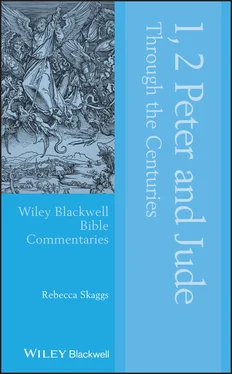Other writers emphasize what it means for Christ to be the cornerstone. Cyril of Alexandria points to the unity he brings: “Peter calls Jesus Christ a chosen and precious stone, fashioned by glory and splendor of divinity … because through one faith it [the stone] binds together in unity the two, Israel and the Gentiles.” ( Catena , CEC 51–52: my tr.). Didymus elaborates on this unity:
Although we are from many different nations, the fact that we have all repented of our sins and accepted a common will and a common mind gives those who have repented one doctrine and one faith. ( Comm. on 1 Peter , PG 39: 1763–1764: my tr.)
Didymus, however, acknowledges the “dark side”; that although Christ is the chosen cornerstone to believers, to those who do not believe, he is “a stone of stumbling and a rock of offense, considered worthless by the builders who have rejected him. These builders are the scribes and the Pharisees” ( Catena , CEC 52–53, my tr.). Bede also shares this particular outlook ( Comm ., 1985: 81–2).
Other early writers examine the reason for this stumbling – is it on account of their own free choice or has it been predetermined by God? Didymus understands the stumbling to be the result of choice: “The position in which they find themselves [as unbelievers] is one which they have chosen, for it starts with unbelief: God was patient with those who despised his mercy, but ultimately left the choice to them” ( Comm. on 1 Peter , PG 39: 1762–1763).
Oecumenius agrees and states very clearly that, “God is not to be held responsible for this, for no cause of damnation can come from him who wants everyone to be saved” (ibid., my tr.).
Not surprisingly, Calvin strongly opposes this understanding and goes further to apply it not only to the Jews of Jesus’ day but also to the papal party of his own day (Calvin, Comm ., 1963: 264).
A number of other writers agree with the application of this passage to Israel; that the status of being the chosen race has been taken from the Jews and given to the Gentiles (for example, see Origen, Sermons on Genesis , 3.5; Didymus the Blind, Comm. on 1 Peter ; Bede, On 1 Peter ). Here, we see a glimpse of the often bitter controversy which was to develop concerning the relation between Christians and Jews. In fact as time progresses, the controversy has become more and more divisive.
On the other hand, there have always been scholars who view Christianity as an outgrowth of Judaism (for an example of modern scholarship on the subject, see New Testament scholar Green. (See also Achtemeier, 1996: 69), who emphasizes Peter’s use of Old Testament language:
To designate the significance of the conversion of his now‐Christian audience … thus highlighting further the embeddedness of Christians in Israel’s story with the result that the Scriptures of Israel are seen more and more as the account of their heritage … especially to show the continuity between followers of Jesus and Israel of old … Peter collapses the historical distinctive between ancient Israel and contemporary Christians in favor of theological unity, but not in order to deny the importance of history. (Green, 2007: 63)
This passage (2:1–10) has been used in a number of church documents. The First Confession of Basel (1534) cites 1 Peter 2:2–4, along with passages from the gospels and Pauline epistles, confirming the divinity of Christ and the Holy Spirit whom he sent (Pelikan II, IV: 275). The First Helvetic Confession (1536) notes vv.2–4, and comments that the church, as living stones, is built upon the person and blood of Christ (ibid.: 286). In response to Question 31, about the anointing of Christ, the Heidelberg Catechism cites vv.5–10 as follows: “through faith … I offer myself a living sacrifice of gratitude to him” (ibid.: 435). This document also refers to this same source regarding the renewal by the Holy Spirit “so that with our whole life we may show ourselves grateful to God for his goodness” (ibid.: 446). The Catechism and Confession of the Polish Brethren (1574) enlists vv.6–8 to support the dual function of the cornerstone which is chosen and precious to those who believe, but “for those who do not believe … will make men stumble” (ibid.: 718–719).
The notion of “holy” in this passage has affected church creeds through the centuries; by the middle of the second century, the word was becoming a “stock epithet” to describe the church. It reflects the Old Testament where it denoted whatever concerned or belonged to God. This passage uses it in reference to the church as “God’s chosen people”; it reflects the creed – they are “holy” because God has predestined it [the church] to a glorious inheritance and they belong to Him through the Holy Spirit (Kelly, 1972: 158–159).
Doctrinal Interpretations: The Priesthood of all Believers
During the Reformation, a doctrine was developed from 1 Peter 1:9 (as well as from parallel passages in the Pauline epistles) by the Lutheran and Reformed Churches, and followed by the Protestant Free Churches, stressing that all humans have direct access to God through Christ, the true high priest, and thus do not need a priestly mediator. This democratic stance meant that all Christians are equal before God and hence the ordained clergy are merely representatives of the congregation, filling the role of preaching and administering the sacraments.
Many early writers interpreted the verse this way. Clement of Alexandria states, “We are priesthood because of the offering which is made in prayers and in the teachings by which souls which are offered to God are won” ( Adumbrations ). Origen also acknowledges that Christ’s redemption results in all Christians being priests: “Because you are a priestly race you are able to approach the sanctuary of God.” But he adds a warning, “do not let the fire depart from your altar” ( Sermons on Leviticus 9.9; Sermons on Leviticus 4.6). Augustine adds his consensus: “In ancient times only one high priest was anointed, but now all Christians are anointed” ( Sermons 198A). Similarly, Leo the Great (400–461) remarks, “All who have been born again in Christ are made kings by the sign of the cross and consecrated priests by the anointing of the Holy Spirit” ( Sermons 4).
Later, Andreas, Severus of Antioch (c. 459), and Bede assert that the priesthood of all Christians is because Christ himself is priest and king. The same way that we are holy because he is holy, we are priests because he is a priest (Andreas, Catena ; Severus, Catena ; Bede, On 1 Peter ).
Religious traditions also differ on their understanding on this issue. For example, The Second Helvetic Confession (1566) makes the point, “Christ’s apostles call all who believe in Christ ‘priests,’ but not on account of an office” (Pelikan II, IV: 500). In contrast, the Westminster Confession of Faith (1642) cites v.5 in regard to “spiritual sacrifices acceptable to God,” but does not stress the point about all Christians being able to fill the role of priest (ibid.: 632). See also the True Confession of the English Separatists (1596) (Pelikan III, V: 36).
From a social‐science perspective, Green (2007: 61) argues that:
Neither here [v.5] nor in v.9 can we find a basis for the Reformation doctrine of “the priesthood of all believers,” not because the doctrine lacks warrant (e.g., 4:10–11), but because Peter’s emphasis is not on the priestly role of each believer but on the priestly identity of God’s people.
Читать дальше












